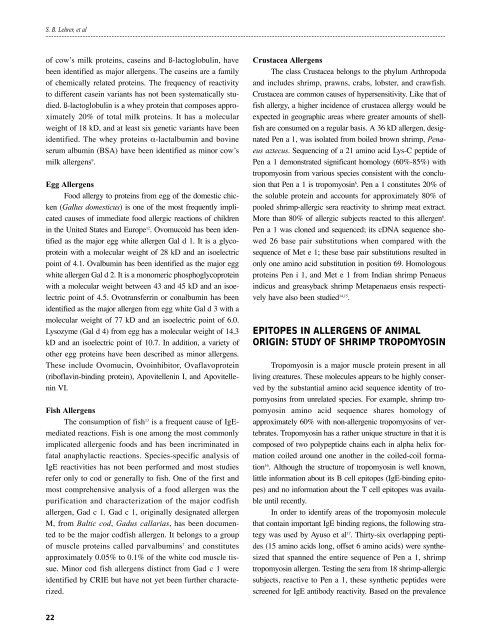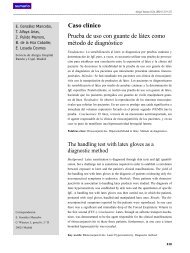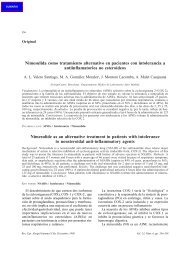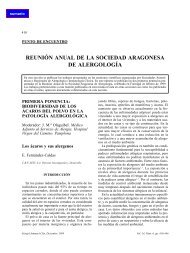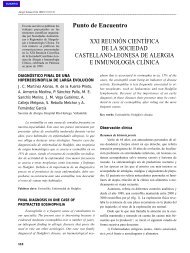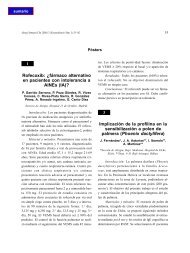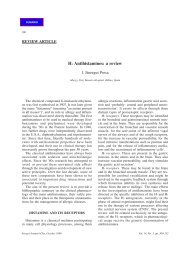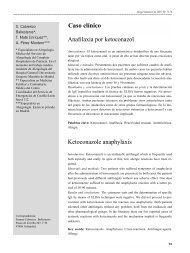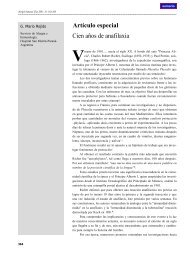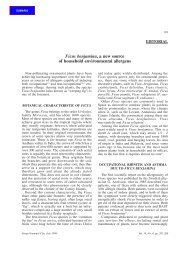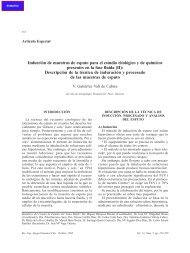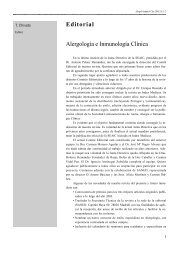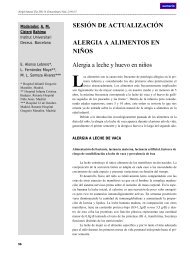Aplicación de la biología molecular en alergia a alimentos
Aplicación de la biología molecular en alergia a alimentos
Aplicación de la biología molecular en alergia a alimentos
Create successful ePaper yourself
Turn your PDF publications into a flip-book with our unique Google optimized e-Paper software.
S. B. Lehrer, et al<br />
of cow’s milk proteins, caseins and ß-<strong>la</strong>ctoglobulin, have<br />
be<strong>en</strong> i<strong>de</strong>ntified as major allerg<strong>en</strong>s. The caseins are a family<br />
of chemically re<strong>la</strong>ted proteins. The frequ<strong>en</strong>cy of reactivity<br />
to differ<strong>en</strong>t casein variants has not be<strong>en</strong> systematically studied.<br />
ß-<strong>la</strong>ctoglobulin is a whey protein that composes approximately<br />
20% of total milk proteins. It has a molecu<strong>la</strong>r<br />
weight of 18 kD, and at least six g<strong>en</strong>etic variants have be<strong>en</strong><br />
i<strong>de</strong>ntified. The whey proteins α-<strong>la</strong>ctalbumin and bovine<br />
serum albumin (BSA) have be<strong>en</strong> i<strong>de</strong>ntified as minor cow’s<br />
milk allerg<strong>en</strong>s 9 .<br />
Egg Allerg<strong>en</strong>s<br />
Food allergy to proteins from egg of the domestic chick<strong>en</strong><br />
(Gallus domesticus) is one of the most frequ<strong>en</strong>tly implicated<br />
causes of immediate food allergic reactions of childr<strong>en</strong><br />
in the United States and Europe 12 . Ovomucoid has be<strong>en</strong> i<strong>de</strong>ntified<br />
as the major egg white allerg<strong>en</strong> Gal d 1. It is a glycoprotein<br />
with a molecu<strong>la</strong>r weight of 28 kD and an isoelectric<br />
point of 4.1. Ovalbumin has be<strong>en</strong> i<strong>de</strong>ntified as the major egg<br />
white allerg<strong>en</strong> Gal d 2. It is a monomeric phosphoglycoprotein<br />
with a molecu<strong>la</strong>r weight betwe<strong>en</strong> 43 and 45 kD and an isoelectric<br />
point of 4.5. Ovotransferrin or conalbumin has be<strong>en</strong><br />
i<strong>de</strong>ntified as the major allerg<strong>en</strong> from egg white Gal d 3 with a<br />
molecu<strong>la</strong>r weight of 77 kD and an isoelectric point of 6.0.<br />
Lysozyme (Gal d 4) from egg has a molecu<strong>la</strong>r weight of 14.3<br />
kD and an isoelectric point of 10.7. In addition, a variety of<br />
other egg proteins have be<strong>en</strong> <strong>de</strong>scribed as minor allerg<strong>en</strong>s.<br />
These inclu<strong>de</strong> Ovomucin, Ovoinhibitor, Ovaf<strong>la</strong>voprotein<br />
(ribof<strong>la</strong>vin-binding protein), Apovitell<strong>en</strong>in I, and Apovitell<strong>en</strong>in<br />
VI.<br />
Fish Allerg<strong>en</strong>s<br />
The consumption of fish 13 is a frequ<strong>en</strong>t cause of IgEmediated<br />
reactions. Fish is one among the most commonly<br />
implicated allerg<strong>en</strong>ic foods and has be<strong>en</strong> incriminated in<br />
fatal anaphy<strong>la</strong>ctic reactions. Species-specific analysis of<br />
IgE reactivities has not be<strong>en</strong> performed and most studies<br />
refer only to cod or g<strong>en</strong>erally to fish. One of the first and<br />
most compreh<strong>en</strong>sive analysis of a food allerg<strong>en</strong> was the<br />
purification and characterization of the major codfish<br />
allerg<strong>en</strong>, Gad c 1. Gad c 1, originally <strong>de</strong>signated allerg<strong>en</strong><br />
M, from Baltic cod, Gadus cal<strong>la</strong>rias, has be<strong>en</strong> docum<strong>en</strong>ted<br />
to be the major codfish allerg<strong>en</strong>. It belongs to a group<br />
of muscle proteins called parvalbumins 7 and constitutes<br />
approximately 0.05% to 0.1% of the white cod muscle tissue.<br />
Minor cod fish allerg<strong>en</strong>s distinct from Gad c 1 were<br />
i<strong>de</strong>ntified by CRIE but have not yet be<strong>en</strong> further characterized.<br />
22<br />
Crustacea Allerg<strong>en</strong>s<br />
The c<strong>la</strong>ss Crustacea belongs to the phylum Arthropoda<br />
and inclu<strong>de</strong>s shrimp, prawns, crabs, lobster, and crawfish.<br />
Crustacea are common causes of hypers<strong>en</strong>sitivity. Like that of<br />
fish allergy, a higher inci<strong>de</strong>nce of crustacea allergy would be<br />
expected in geographic areas where greater amounts of shellfish<br />
are consumed on a regu<strong>la</strong>r basis. A 36 kD allerg<strong>en</strong>, <strong>de</strong>signated<br />
P<strong>en</strong> a 1, was iso<strong>la</strong>ted from boiled brown shrimp, P<strong>en</strong>aeus<br />
aztecus. Sequ<strong>en</strong>cing of a 21 amino acid Lys-C pepti<strong>de</strong> of<br />
P<strong>en</strong> a 1 <strong>de</strong>monstrated significant homology (60%-85%) with<br />
tropomyosin from various species consist<strong>en</strong>t with the conclusion<br />
that P<strong>en</strong> a 1 is tropomyosin 6 . P<strong>en</strong> a 1 constitutes 20% of<br />
the soluble protein and accounts for approximately 80% of<br />
pooled shrimp-allergic sera reactivity to shrimp meat extract.<br />
More than 80% of allergic subjects reacted to this allerg<strong>en</strong> 6 .<br />
P<strong>en</strong> a 1 was cloned and sequ<strong>en</strong>ced; its cDNA sequ<strong>en</strong>ce showed<br />
26 base pair substitutions wh<strong>en</strong> compared with the<br />
sequ<strong>en</strong>ce of Met e 1; these base pair substitutions resulted in<br />
only one amino acid substitution in position 69. Homologous<br />
proteins P<strong>en</strong> i 1, and Met e 1 from Indian shrimp P<strong>en</strong>aeus<br />
indicus and greasyback shrimp Metap<strong>en</strong>aeus <strong>en</strong>sis respectively<br />
have also be<strong>en</strong> studied 14,15 .<br />
EPITOPES IN ALLERGENS OF ANIMAL<br />
ORIGIN: STUDY OF SHRIMP TROPOMYOSIN<br />
Tropomyosin is a major muscle protein pres<strong>en</strong>t in all<br />
living creatures. These molecules appears to be highly conserved<br />
by the substantial amino acid sequ<strong>en</strong>ce i<strong>de</strong>ntity of tropomyosins<br />
from unre<strong>la</strong>ted species. For example, shrimp tropomyosin<br />
amino acid sequ<strong>en</strong>ce shares homology of<br />
approximately 60% with non-allerg<strong>en</strong>ic tropomyosins of vertebrates.<br />
Tropomyosin has a rather unique structure in that it is<br />
composed of two polypepti<strong>de</strong> chains each in alpha helix formation<br />
coiled around one another in the coiled-coil formation<br />
16 . Although the structure of tropomyosin is well known,<br />
little information about its B cell epitopes (IgE-binding epitopes)<br />
and no information about the T cell epitopes was avai<strong>la</strong>ble<br />
until rec<strong>en</strong>tly.<br />
In or<strong>de</strong>r to i<strong>de</strong>ntify areas of the tropomyosin molecule<br />
that contain important IgE binding regions, the following strategy<br />
was used by Ayuso et al 17 . Thirty-six over<strong>la</strong>pping pepti<strong>de</strong>s<br />
(15 amino acids long, offset 6 amino acids) were synthesized<br />
that spanned the <strong>en</strong>tire sequ<strong>en</strong>ce of P<strong>en</strong> a 1, shrimp<br />
tropomyosin allerg<strong>en</strong>. Testing the sera from 18 shrimp-allergic<br />
subjects, reactive to P<strong>en</strong> a 1, these synthetic pepti<strong>de</strong>s were<br />
scre<strong>en</strong>ed for IgE antibody reactivity. Based on the preval<strong>en</strong>ce


